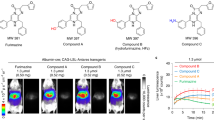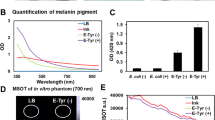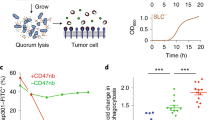Abstract
We have shown that bacteria injected intravenously into live animals entered and replicated in solid tumors and metastases. The tumor-specific amplification process was visualized in real time using luciferase-catalyzed luminescence and green fluorescent protein fluorescence, which revealed the locations of the tumors and metastases. Escherichia coli and three attenuated pathogens (Vibrio cholerae, Salmonella typhimurium, and Listeria monocytogenes) all entered tumors and replicated. Similarly, the cytosolic vaccinia virus also showed tumor-specific replication, as visualized by real-time imaging. These findings indicate that neither auxotrophic mutations, nor vaccinia virus deficient for the thymidine kinase gene, nor anaerobic growth conditions were required for tumor specificity and intratumoral replication. We observed localization of tumors by light-emitting microorganisms in immunocompetent and in immunocompromised rodents with syngeneic and allogeneic tumors. Based on their 'tumor-finding' nature, bacteria and viruses may be designed to carry multiple genes for detection and treatment of cancer.
This is a preview of subscription content, access via your institution
Access options
Subscribe to this journal
Receive 12 print issues and online access
$209.00 per year
only $17.42 per issue
Buy this article
- Purchase on Springer Link
- Instant access to full article PDF
Prices may be subject to local taxes which are calculated during checkout





Similar content being viewed by others
References
Abelmann, H.W. in Cancer as I See It (Philosophical Library, Inc., New York, 1951).
Llinares, P. et al. Infected atrial myxoma simulating infective endocarditis. Enferm. Infecc. Microbiol. Clin. 11, 378–381 (1993).
Liao, W.Y. et al. Bacteriology of infected cavitating lung tumor. Am. J. Respir. Crit. Care Med. 161, 1750–1753 (2000).
Di Virgilio, G., Lavenda, N. & Siegel, D. Viral particles in human breast cancer. Oncologia 19, 341–348 (1965).
Williamson, A.L., Jaskiesicz, K. & Gunning, A. The detection of human papillomavirus in oesophageal lesions. Anticancer Res. 11, 263–265 (1991).
Liu, B. et al. Identification of a proviral structure in human breast cancer. Cancer Res. 61, 1754–1759 (2001).
Chang, F., Syrjanen, S., Shen, Q., Wang, L. & Syrjanen, K. Screening for human papillomavirus infections in esophageal squamous cell carcinomas by in situ hybridization. Cancer 72, 2525–2530 (1993).
Lemmon, M.J. et al. Anaerobic bacteria as a gene delivery system that is controlled by the tumor microenvironment. Gene Ther. 4, 791–796 (1997).
Pawelek, J.M., Low, K.B. & Bermudes, D. Tumor-targeted Salmonella as a novel anti-cancer vector. Cancer Res. 57, 4537–4544 (1997).
Sauter, B.V., Martinet, O., Zhang, W., Mandeli, J. & Woo, S.L.C. Adenovirus-mediated gene transfer of endostatin in vivo results in high level of transgene expression and inhibition of tumor growth and metastases. Proc. Natl. Acad. Sci. USA 97, 4802–4807 (2000).
Gordon, E.M. et al. Systemic administration of a matrix-targeted retroviral vector is efficacious for cancer gene therapy in mice. Hum. Gene Ther. 12, 193–204 (2001).
Block, A. et al. Gene therapy of metastatic colon carcinoma: regression of multiple hepatic metastases by adenoviral expression of bacterial cytosine deaminase. Cancer Gene Ther. 7, 438–445 (2000).
Chen, C.T. et al. Antiangiogenic gene therapy for cancer via systemic administration of adenoviral vectors expressing secretable endostatin. Hum. Gene Ther. 11, 1983–1996 (2000).
Gnant, M.F.X. et al. Tumor-specific gene delivery using recombinant vaccinia virus in a rabbit model of liver metastases. J. Natl. Cancer Inst. 91, 1744–1750 (1999).
Gnant, M.F., Puhlmann, M., Bartlett, D.L. & Alexander, H.R. Jr. Regional versus systemic delivery of recombinant vaccinia virus as suicide gene therapy for murine liver metastases. Ann. Surg. 230, 352–360 (1999).
McCart, J.A. et al. Complex interactions between the replicating oncolytic effect and the enzyme/prodrug effect of vaccinia-mediated tumor regression. Gene Ther. 7, 1217–1223 (2000).
Puhlmann, M. et al. Vaccinia as a vector for tumor-directed gene therapy: biodistribution of a thymidine kinase-deleted mutant. Cancer Gene Ther. 7, 66–73 (2000).
Belas, R. et al. Bacterial bioluminescence: isolation and expression of the luciferase genes from Vibrio harveyi. Science 218, 791–793 (1982).
De Wet, J.R., Wood, K.V., Deluca, M., Helinski, D.R. & Subramani, S. Firefly luciferase gene: structure and expression in mammalian cells. Mol. Cell. Biol. 7, 725–737 (1987).
Prasher, D.C., McCann, R.O., Longiaru, M. & Cormier, M.J. Sequence comparisons of complementary DNAs encoding aequorin isotypes. Biochem. 26, 1326–1332 (1987).
Foran, D.R. & Brown, W.M. Nucleotide sequence of the LuxA and LuxB genes of the bioluminescent marine bacterium Vibrio fischeri. Nucleic Acids Res. 16, 777 (1988).
Escher, A., O'Kane, D.J., Lee, J. & Szalay, A.A. Bacterial luciferase αβ fusion protein is fully active as a monomer and highly sensitive in vivo to elevated temperature. Proc. Natl. Acad. Sci. USA 86, 6528–6532 (1989).
Lorenz, W.W., McCann, R.O., Longiaru, M. & Cormier, M.J. Isolation and expression of a cDNA encoding Renilla reniformis luciferase. Proc. Natl. Acad. Sci. USA 88, 4438–4442 (1991).
Prasher, D.C., Eckenrode, V.K., Ward, W.W., Prendergast, F.G. & Cormier, M.J. Primary structure of the Aequorea victoria green-fluorescent protein. Gene 111, 229–233 (1992).
Engebrecht, J., Simon, M. & Silverman, M. Measuring gene expression with light. Science 227, 1345–1347 (1985).
Legocki, R.P., Legocki, M., Baldwin, T.O. & Szalay, A.A. Bioluminescence in soybean root nodules: demonstration of a general approach to assay gene expression in vivo using bacterial luciferase. Proc. Natl. Acad. Sci. USA 83, 9080–9084 (1986).
Chalfie, M., Tu, Y., Euskirchen, G., Ward, W.W. & Prasher, D.C. Green fluorescent protein as a marker for gene expression. Science 263, 802–805 (1994).
Langridge, W.H.R. et al. A luciferase marker gene system to monitor gene expression in bacteria, plant and virus infected animal cells. Proceedings of the VIIth Int. Symp. on Bio & Chemiluminescence, Banff, Canada, March 14–18, 1993 (eds. Szalay, A.A. et al.) 222–226 (Wiley, Chichester, UK, 1993).
O'Kane, D.J. et al. Visualization of bioluminescence as a marker of gene expression in Rhizobium-infected soybean root nodules. J. Plant Mol. Biol. 10, 387–399 (1988).
Wang, G., Mayerhofer, R., Langridge, W.H.R. & Szalay, A.A. in Proceedings of the VIIth Int. Symp. on Bio & Chemiluminescence, Banff, Canada, March 14–18, 1993 (eds. Szalay, A.A. et al.) 232–238 (Wiley, Chichester, UK, 1993).
Giacomin, L.T. & Szalay, A.A. Expression of a PALI promoter luciferase gene fusion in Arabidopsis thaliana in response to infection by phytopathogenic bacteria. Plant Sci. 116, 59–72 (1996).
Lee, C.Y., Szittner, R. & Meighen, E.A. The lux genes of the luminous bacterial symbiont, Photobacterium leiognathi, of the ponyfish. Nucleotide sequence, difference in gene organization and high expression in mutant Escherichia coli. Eur. J. Biochem. 201, 161–167 (1991).
Meighen, E.A. & Szittner, R. Multiple repetitive elements organization of the lux operons of luminescent terrestrial bacteria. J. Bacteriol. 174, 5371–5381 (1992).
Fernandez-Pinas, F. & Wolk, C.P. Expression of luxCD-E in Anabaena sp. can replace the use of exogenous aldehyde for in vivo localization of transcription by luxAB. Gene 150, 169–174 (1994).
Contag, C.H. et al. Photonic detection of bacterial pathogens in living hosts. Mol. Microbiol. 18, 593–603 (1995).
Shabahang, S. & Szalay, A.A. in Proceedings of the 11th International Symposium on Bioluminescence and Chemiluminescence, Pacific Grove, CA, September 6–10, 2000 (eds. Case, J.F. et al.) 449–452 (World Scientific, Singapore, 2001).
Wang, Y., Wang, G., O'Kane, D.J. & Szalay, A.A. in Proceedings of the 9th International Symposium on Bioluminescence and Chemiluminescence, Woods Hole, MA, October 4–8, 1996 (eds. Hastings, J.W. et al.) 419–422 (Wiley, Chichester, UK, 1996).
Wang, Y., Wang, G., O'Kane D.J. & Szalay A.A. Chemiluminescence energy transfer to study protein-protein interaction in living cells. Mol. Gen. Genet. 264, 578–587 (2001).
Wang, Y, Yu Y., Shabahang, S., Wang, G. & Szalay, A.A. Functional Renilla luciferase–Aequorea GFP (RUC-GFP) fusion protein as a novel dual reporter for imaging of gene expression in cell cultures and in live animals. Mol. Gen. Genet. 268, 160–168 (2002).
Timiryasova, T., Yu, Y.A., Shabahang, S., Fodor, I. & Szalay, A.A. in Proceedings of the 11th International Symposium on Bioluminescence and Chemiluminescence, Pacific Grove, CA, September 6–10, 2000 (eds. Case, J.F. et al.) 457–460 (World Scientific, Singapore, 2001).
Gebauer, G., Jager, W. & Lang, N. mRNA expression of components of the insulin-like growth factor system in breast cancer cell lines, tissues, and metastatic breast cancer cells. Anticancer Res. 18, 1191–1195 (1998).
Padera, T.P. et al. Lymphatic metastasis in the absence of functional intratumor lymphatics. Science 296, 1883–1886 (2002).
Mose, J.R. & Mose, G. Oncolysis by Clostridia. I. Activity of Clostridium butyricum (M-55) and other nonpathogenic Clostridia against the Ehrlich carcinoma. Cancer Res. 24, 212–216 (1964).
Dang, L.H., Bettegowda, C., Huso, D.L., Kinzler, K.W. & Vogelstein, B. Combination bacteriolytic therapy for the treatment of experimental tumors. Proc. Natl. Acad. Sci. USA 98, 15155–15160 (2001).
Yazawa, K., Fujimori, M., Amano, J., Kano, Y. & Taniguchi, S. Bifidobacterium longum as a delivery system for cancer gene therapy: selective localization and growth in hypoxic tumors. Cancer Gene Ther. 7, 269–274 (2000).
Sznol, M., Lin, S.L., Bermudes, D., Zheng, L.M. & King, I. Use of preferentially replicating bacteria for the treatment of cancer. J. Clin. Invest. 105, 1027–1030 (2000).
Ramshaw, I., Ruby, J., Ramsay, A., Ada, G. & Karupiah, G. Expression of cytokines by recombinant vaccinia virus: a model for studying cytokines in virus infections in vivo. Immun. Rev. 127, 157–182 (1992).
Gnant, M.F.X., Puhlmann, M., Alexander, H.R. & Bartlett, D.L. Systemic administration of a recombinant vaccinia virus expressing the cytosine deaminase gene and subsequent treatment with 5-fluorocytosine leads to tumor-specific gene expression and prolongation of survival in mice. Cancer Res. 59, 3396–3403 (1999).
Voisey, C.R. & Marincs, F. Elimination of internal restriction enzyme sites from a bacterial luminescence (luxCDABE) operon. Biotechniques 24, 56–58 (1998).
Acknowledgements
The authors thank M. Lilly for generating mice with bladder tumors, I. Fodor for help with prostate tumor mice and for access to the rVV-RUC-GFP virus, D. Gridley for developing intracranial glioma tumors, D. deLeon and J. Tian for mice with MCF-7 implants and K. Oberg for access to the stereo fluorescence microscope. We would like to acknowledge the help and scientific criticisms of C. Slattery and F. Grummt during the preparation of this manuscript. Y.A.Y. was a recipient of a graduate fellowship from LLU. The research was supported in part by LLU, by Genelux, by an SFB travel award to A.A.S., by the research prize from A.V. Humboldt Foundation, Germany, awarded to A.A.S., and by an SFB award to W.G.
Author information
Authors and Affiliations
Corresponding author
Ethics declarations
Competing interests
A.A.S. is a cofounder and shareholder of Genelux. Y.A.Y., T.M.T. and Q.Z. are employed by Genelux.
Rights and permissions
About this article
Cite this article
Yu, Y., Shabahang, S., Timiryasova, T. et al. Visualization of tumors and metastases in live animals with bacteria and vaccinia virus encoding light-emitting proteins. Nat Biotechnol 22, 313–320 (2004). https://doi.org/10.1038/nbt937
Received:
Accepted:
Published:
Issue Date:
DOI: https://doi.org/10.1038/nbt937
This article is cited by
-
Engineered E. coli Nissle 1917 for delivery of bioactive IL-2 for cancer immunotherapy
Scientific Reports (2023)
-
In vivo bioluminescence imaging of natural bacteria within deep tissues via ATP-binding cassette sugar transporter
Nature Communications (2023)
-
Applications of synthetic biology in medical and pharmaceutical fields
Signal Transduction and Targeted Therapy (2023)
-
Phenolic compounds removal in table olive processing wastewater by column adsorption: conditions’ optimization
Environmental Science and Pollution Research (2023)
-
Bacteria-driven hypoxia targeting delivery of chemotherapeutic drug proving outcome of breast cancer
Journal of Nanobiotechnology (2022)



